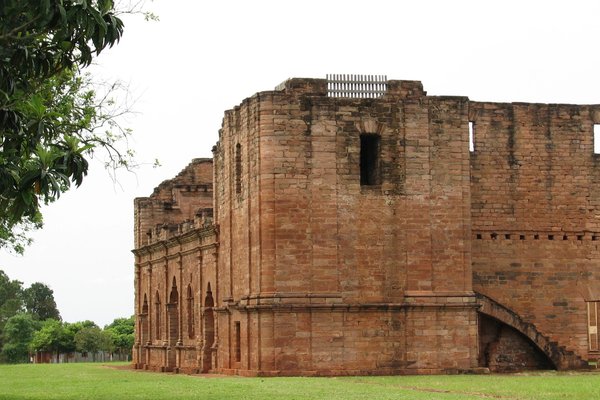Paraguay
Jesuit Missions of Trinidad and Jesus
The Jesuit Missions of La Santisima Trinidad de Parana and Jesus de Tavarangue are the remains of small colonies established by the Jesuits in Paraguay throughout the 17th and 18th century.
They were built as miniature city-states that integrated the indigenous Guarani populations with the Christian faith. The mission of Trinidad was originally constructed in 1706, the intended self-sufficient city came complete with a central meeting plaza, a large church meetinghouse, a school, several workshops, a museum and housing for the local Indian population. The nearby mission of Jesus de Tavarangue was created in 1685.
Community Perspective: Well-preserved, with stunning carvings done by the Indian craftsmen, and “no tour groups, no guides, no information signs, and no sound”. Trinidad is easily accessible by bus from the nearby city of Encarnacion, while Jesus de Tavarangue requires an additional taxi ride. It can also be done on a half-day trip from the Argentinian town of Posadas. See the reviews of Nan and Shandos for public transport logistics in this border region.
Site Info
Official Information
- Full Name
- Jesuit Missions of La Santisima Trinidad de Parana and Jesus de Tavarangue (ID: 648)
- Country
- Paraguay
- Status
-
Inscribed 1993
Site history
History of Jesuit Missions of Trinidad and Jesus
- 1993: Revision
- Originally a third Paraguayan mission was proposed (Santos Cosme y Damian), but this one was withdrawn after the ICOMOS evaluation reported that it should be omitted.
- 1993: Inscribed
- Inscribed
- Type
- Cultural
- Criteria
- iv
Links
- UNESCO
- whc.unesco.org
- Official
-
- uninet.com.py — Turismo Paraguay
- Related
-
- en.wikipedia.org — Jesús and Trinidad Jesuit Ruins at Wikipedia
All Links
UNESCO.org
- whc.unesco.org — whc.unesco.org/
Official Website
- uninet.com.py — Turismo Paraguay
Related Resources
- en.wikipedia.org — Jesús and Trinidad Jesuit Ruins at Wikipedia
Community Information
- Community Category
- Religious structure: Christian
Travel Information
Recent Connections
-
Perfect Inscriptions
1993 -
Río de la Plata Basin
On the Parana -
Extensions on Tentative List
Jesuit Mission of San Cosme y San Damiá…
Connections of Jesuit Missions of Trinidad and Jesus
- Geography
-
-
Contiguous separate sites across national boundaries
Paraguay vs Argentina/Brazil (request for combination by AB ev) -
Río de la Plata Basin
On the Parana
-
- History
-
-
Guarani
The missions were built as miniature city-states that integrated the indigenous Guarani populations with Christian faith.
-
- Architecture
- World Heritage Process
-
-
Recommended for combination by AB
AB Eval 1993 - "That the inscription of this group of properties on the List be referred back to the Government of Paraguay, who should be invited to give consideration to resubmitting this nomination (omitting Santos Cosme y Damian) as an extension of the existing joint Argentinian-Brazilian inscription, under the title "Jesuit Missions of the Guayra", and the redefinition of the buffer zones. " The recorded decison was "The Committee inscribed the site on the World Heritage List under criterion (iv). The Committee invited Brazil, Argentina and Paraguay to consider a joint inscription of the Jesuit missions on their territories. The Delegate of Brazil would welcome a joint conservation effort and announced that such an initiative was being taken in the context of MERCOSUR." -
Only WHS in their country
-
Extensions on Tentative List
Jesuit Mission of San Cosme y San Damián (Paraguay) -
Perfect Inscriptions
1993 -
Inscribed on a single criterion only
iv. to be an outstanding example of a type of building, architectural or technological ensemble or landscape which illustrates (a) significant stage(s) in human history -
First inscriptions
Paraguay 1993
-
- Religion and Belief
- Timeline
-
-
Built in the 17th century
1685 and 1706
-
News
No news.
Recent Visitors
Visitors of Jesuit Missions of Trinidad and Jesus
- Adrian Turtschi
- Alberto Rodriguez Gutierrez
- Alejandro Lau
- Ammon Watkins
- Ana
- Anna Wludarska
- basementonline
- Bill Maurmann
- Bram de Bruin
- Carlos Sotelo
- Christoph
- Christravelblog
- ctravel
- Cyberczar
- CynthiaW
- Daniela Hohmann
- dave wood
- del
- Els Slots
- Erik Jelinek
- Feldhase
- Filip Murlak
- Frédéric M
- Gernot
- Grendel Gongan
- Harry Mitsidis
- hotpickle
- Iain Jackson
- Jarek Pokrzywnicki
- Jawnbeary
- Jens
- J_neveryes
- João Aender
- Joel on the Road
- Jon Opol
- Karito Vies
- KeithBailey
- kelseyyurek
- Loic Pedras
- Lucio
- Luis Filipe Gaspar
- Lukasz Palczewski
- Maciej Gil
- marcel staron
- Max
- Michael Ayers
- Michael Turtle
- Mikko
- MMM
- nan
- Patrik
- Philipp Peterer
- pressdm
- Reza
- Roman Bruehwiler
- Shandos Cleaver
- Solivagant
- Stanislaw Warwas
- Tevity
- Thomas van der Walt
- Tim Allen
- Timonator
- Timothy C Easton
- Truls Brekke
- Veronica
- Walter
- Wojciech Fedoruk
- zfish
- Zoë Sheng
Community Reviews
Show full reviews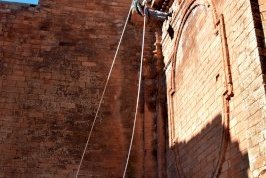
Poor Paraguay - overlooked by many who visit South America. It has no world-class sightseeing site, and its only major city - Asuncion - is too gritty and unpolished for many tourists. Jesuit Missions of Trinidad and Jesús de Tavarangue are probably the highlight of Paraguay's sights, but you will likely have these UNESCO world heritage sites to yourself.
I took a bus from Asuncion to Encarnación for a two-night stay. Encarnación is a small tranquil city that is best known for its annual Carnival. There is not much to see in the city itself. In one museum, the staff took a photo of me and promptly posted on their Facebook page that they had a visitor from Canada.
The Jesuit Mission of Trinidad site (photo) is fairly easy to get to from Encarnación as there are decent number of buses that regularly pass it. As I had not been to the Argentinian Jesuit missions yet, I found the site to be very novel and interesting. Even though the main church was only partially standing, there is more than enough standing for one to appreciate its grandeur and craftmanship. Ruins or foundations of the houses were also visible. I shared the large open site with perhaps just a couple of other tourists.
Jesús de Tavarangue is close enough to Trinidad that you can very easily visit both on the same day, but it is far enough that you probably want to do so by car or bus …
Keep reading 0 commentsShandos Cleaver
Jesuit Missions of Trinidad and Jesus
Jesuit Missions of Trinidad and Jesus (Inscribed)
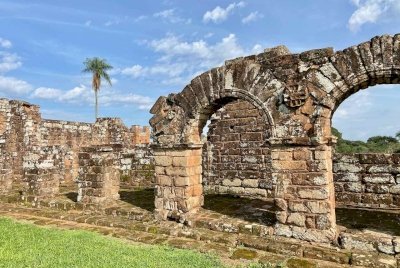
In South America, there are at least 4 separate World Heritage Sites related to the Jesuits: the Jesuit Missions of the Chiquitos in Bolivia (which are still living towns and churches), the Jesuit Block and Estancias of Cordoba in Argentina, the Jesuit Missions of the Guaranis in Argentina and Brazil, and finally the Jesuit Missions of Trinidad and Jesus, the lone site in Paraguay. The latter two sites (all in ruins) could have actually been combined, they are even in the same tourist route, but then far fewer of us would have probably visited Paraguay.
Initially, we had planned to do as others had done and visit the Trinidad on a half-day trip from Posadas in Argentina. But thanks to our preferred hotels selling out (a common occurrence during the Argentine holidays), we thought we'd spend a couple of nights in Paraguay (we also had a couple of nights free to line up with our "cheap" flight out of Foz de Iguazu). After all, it wasn't a micro-country and deserved at least a night's stay to tick off the country.
After our previous two overnight buses in Argentina arrived 1 hour early, our bus to Posadas arrived an hour late, not ideal considering it was scheduled to arrive at 9:20 and we hadn't packed breakfast. After a detour for breakfast, it was then a slow trip across the border on the international bus, meandering through Posadas and stopping at both sides. After checking into our hotel and changing …
Keep reading 0 comments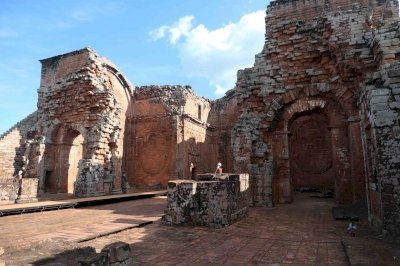
After two weeks of passing through the south of Paraguay of course I could not miss the only world heritage site in the country before re-entering Argentina via Encarnación/ Posadas. Paraguay is really not the place of the top sights but what will be kept in mind is that every Paraguayan I have met in the two weeks was very kind and that the country is fantastically cheap to travel.
Getting to Trinidad from Encarnación is easily possible from the Terminal of Encarnación by asking one of the many people for a bus to Trinidad. Usually you will end up sitting in a bus to Ciudad del Este that can drop you off at Trinidad bus station, a little laterite hut at the side of the Ruta (highway) in front of a gateway marking the entrance of the city when asking the driver or his/her assistant ahead. It costs about 5 USD when I remember it right.
After a 15 minute walk you arrive at the visitor center of Trinidad, where there is a small exhibition about the map of the time of South America (Trinidad was founded in 1706), some paintings showing the situation or interpretation of it and some carvings. Additionally a movie is shown for you which style reminded me of some of the 80´s documentation that I had to watch in biology in school. However it was even available in German and gave some interesting information about the mission and the general situation with …
Keep reading 0 comments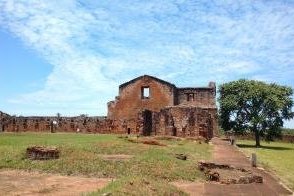
One can lament the quirks of the Unesco process where a site like the Jesuit Missions of the Guaranis gets inscribed twice: once for Paraguay and once for Brazil and Argentina. To me and others the separate inscription was a welcome reason to venture into Paraguay for a day trip on my route from Posadas to Puerto de Iguazu.
In the morning I had flown into Posadas from Buenos Aires. I dropped my luggage off at the main bus station in Posadas and then jumped onto a local bus to Encarcion in Paraguay. Encarcion lies across the Rio Parana and is plastered with Duty Free shops, courtesy of some crazy tariffs and taxes the Argentinians put in place.
From Encarcion I took another bus to Trinidad and visited the great ruins of the Jesuit mission. It’s certainly one of the nicest ruins; I would put it on the same level as nearby San Ignacio de Mini in Argentina.
Initially, I had planned to also go and see the other site in Jesus de Tavarangue. Lonely Planet had promised me a collectivo or a cab readily waiting at a junction nearby. But neither of these options materialized. I briefly tried my luck with hitchhiking, but my heart wasn’t in it that day. It was way too warm and I close to a sunburn. Seeing I also needed to cover additional distance to San Ignacio that evening I decided to call it a day and I returned …
Keep reading 0 commentsMichael Turtle
Jesuit Missions of Trinidad and Jesus
Jesuit Missions of Trinidad and Jesus (Inscribed)
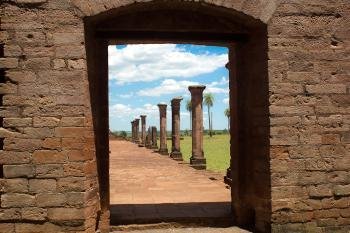
At the ruins of both communities, which are about 12 kilometres apart, you can get a sense of how life must once have been. The focus of both is the church, in each case a huge imposing building that dominates the area. The natives and the Europeans lived separately and their accommodation was on either side of this church… although I’m sure they didn’t let their god come between them.
Walking around the Jesuit ruins as a tourist was a strange experience. At both places there were only a handful of other visitors. There were no tour groups, no guides, no information signs and no sound. Far from highways and the local villages, you can explore these ruins by yourself in peace.
They are beautiful places – partly for the architecture, partly for the way the colours of the buildings mix with the sky and the forests surround them, and partly for the way that you are able to visit them.
Keep reading 0 comments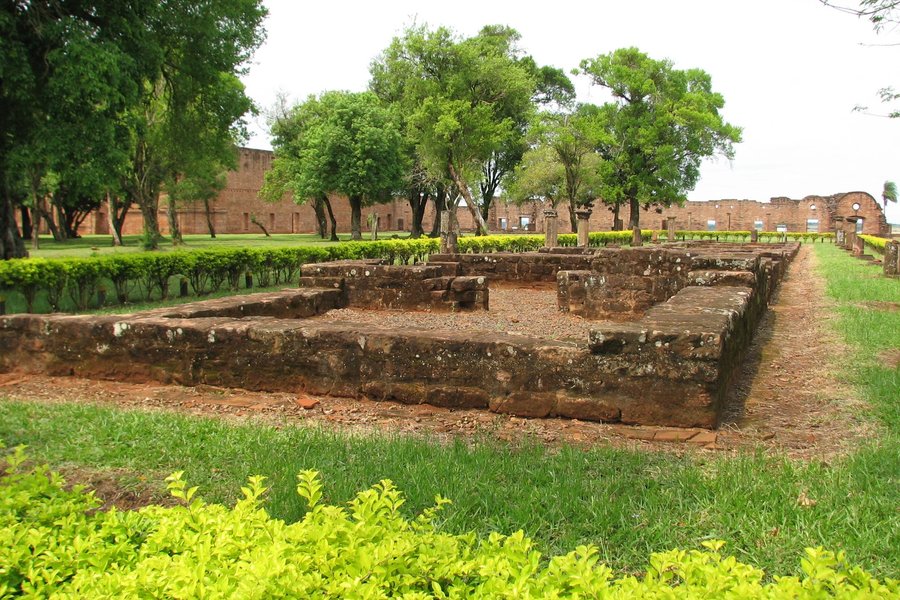
Visited this WHS in August 2013. I got there with a private drive from Asuncion to Posadas and from Posadas Argentina Explored the two missions. To my surprise they were very very well preserved. Didn't see that many tourist there and for that I can see they do a good job there compared to many well visited other sites. For me, being from Europe, it was great to see such architecture in the middle of the jungle. WHen I visited they had information in English, and sometimes little English speaking guide. Further it was all well documented with a tourist office which information about the site.
For my full story and photos see here:
www.christravelblog.com/paraguay-asuncion-encarnacion-jesuit-missions-2013-07-31-2013-08-11-s-a-trip/
Keep reading 0 comments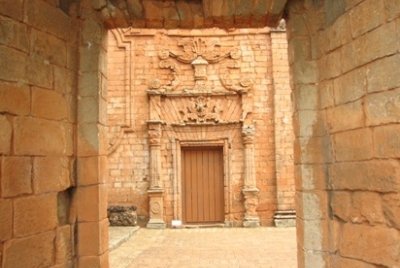
I would probably never have gone to Paraguay if this site hadn't won a separate place on the World Heritage List. As stated above, it represents the same heritage as the missions just across the border in Argentina and Brazil. However, the Jesuit mission of Trinidad probably is the best of them all. There was one other visitor when I arrived at the complex. As a whole, it looked well-maintained.
The site is huge, with a cathedral-like church as the central point. There's another church on site - there were two cemeteries and two kinds of housing as well. Always one for the missionaries and one for the natives. Not really a utopia, after all, wasn't it?
The Trinidad church still has great sculptures. Despite its partly ruined state, one can easily imagine this to be a classical catholic church. Even the crypt and the baptismal font have survived. The site in general looks very peaceful. The grounds are covered with little white flowers, like snowflakes. Its setting reminded me a lot of another outpost WHS, the Buddhist Vihara at Paharpur (Bangladesh).
About 11 km down the road lies Jesus de Tavarangue. This site looks if it has a different layout from the others, or it might be that much of the housing has gone. The only large monument still standing upright is the colossal church.
Entrance to the sites costs 5000 guaranis each. Small denominations of Argentinian pesos are accepted too, but you will get …
Keep reading 0 comments
I visited the Jesuit Missions of Trinidad in August 2004. The site is accessible from the nearby city of Encarnacion (about 45 minutes) by any number of busses (about 50 cents United States) traveling frequently on the paved highway to Ciudad del Este. From the highway it's about a 10 minute walk to the site on a well marked road. Food and drink are available from roadside stands. Entrance fee is less than 50 cents in United States currency and there were only three other visitors.
A hugh roofless baroque Jesuit church that would not be out of place in a major European city dominates the site which has been cleared of any remains of the jungle that once surrounded it. The carvings of the statues, the pulpit, the baptismal font and on the walls are stunning in their beauty and amazing in that they were done by the Indian craftsmen gathered into the mission by the Jesuits in the 17th century and have survived over three hundered years of exposure. The original decorated stone floor is still visible and there is a crypt under the church into which visitors can descend. There is also a watchtower which you can climb to get a beautiful view of the site and surroundings. Remains of workshops, housing and storerooms also remain. To contemplate the work, artistry and devotion that went into building this complex in the middle of a tropical jungle gives insight into the religious fervor that drove the original Spanish …
Keep reading 0 comments
